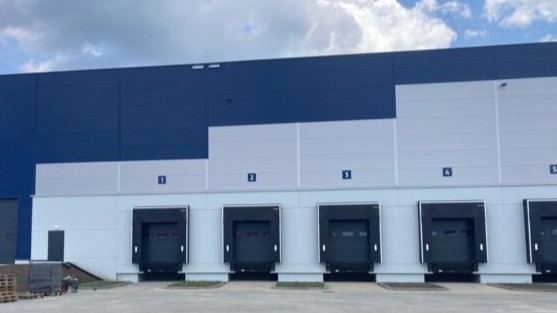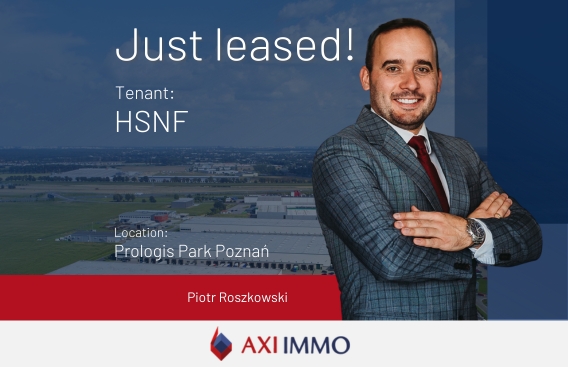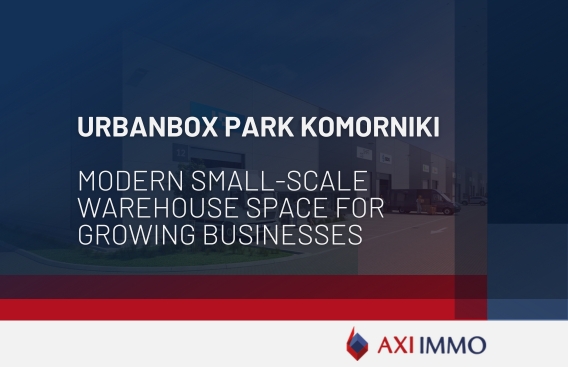Report: Report: Warehouse market in Poland summary 2016 and forecasts for the 2017
AXI IMMO presents the report: Warehouse market in Poland - summary of 2016.

The publication includes information about the demand, supply, availability of the space, rates of rents and forecasts for the warehouse market in Poland for the section of commercial premises in 2017.
2016 will go down in the history of the warehouse sector in Poland. Gross demand achieved a record level and amounted to more than 3 million square metres, of which 70% were within new leases. The main driving force was the e-commerce sector and the expansion of companies already present in Poland, including logistics operators, retail chains, and automotive companies.
New developments followed the needs of tenants, resulting in more than 1.25 million square metres of new warehouse space completed and 1.3 million square metres under construction. High absorption of space and many BTS and pre-let investments did not increase the level of vacancies significantly, which at the end of the year amounted to 6.0%, according to the AXI IMMO report.
INVESTMENT MARKET: Warehouse – the desired investment product
2016 was a very successful year in the investment market in Poland, despite uncertainties associated with international political events. Poland remains the leader in Central and Eastern Europe.
The volume of investment transactions at the end of 2016 exceeded EUR 4.56 billion, of which EUR 770 million fell within the industrial sector.
The Polish real estate investment market is becoming deeper and more differentiated, resulting in an influx of new investors from Africa, Asia, and the US. The volume of investment transactions at the end of 2016 exceeded EUR 4.56 billion, of which EUR 770 million fell within the industrial sector. This result is 67% higher compared with the same period last year.
Last year’s most important investment transactions included the purchase of the P3 portfolio by GIC Real Estate and the Hillwood portfolio by CBRE GI. Competitive rates of return on investment, compared with Western Europe, with very good results in the rental market, are a key factor in the growth of the investment market.
Negotiations are underway for several large projects, allowing an optimistic forecast for 2017. It should be emphasised that the concentration of investors in the major logistics hubs is a continuing trend. New locations are still too risky from the point of view of funding projects, especially in the face of an uncertain tax situation. Currently, the largest risk factor putting the brakes on some transactions are uncertainties associated with VAT interpretations when buying and selling investments – comments Renata Osiecka, Managing Partner AXI IMMO.
DEMAND: Traditional markets – again on top. Good perspective on new locations
Last year surpassed the record results of 2015. In 2016, 3.09 million square metres were leased, of which more than 2.18 million constituted new contracts and expansions. This result is 25% higher compared with the same period last year.
The high volume of transactions was due to the strong expansion of companies present in Poland and major investments from the e-commerce and manufacturing sectors. Traditional markets were the most attractive, with Warsaw in the lead, where 818,000 sqm were leased, of which more than 740,000 sqm were outside the city boundaries. In second place was Upper Silesia, with gross demand at the level of 521,000 sqm. Apart from the main markets, 2016 was a good year for new locations, especially Szczecin and Bydgoszcz. In Szczecin, contracts were signed for 343,000 sqm, of which new leases made up 95%. In Bydgoszcz, the retail chains Kaufland and Carrefour developed rapidly.
Lower labour costs, availability of staff, constantly improving road infrastructure opening up new opportunities and the potential of local markets are the key success factors in new regions. In 2017, we will observe the development of further locations such as Kielce, Bialystok and Zielona Gora. Due to the large manufacturing investments and the proximity of the border with Germany, the Lubuskie region may be a hot new location on the Polish warehouse map – adds Renata Osiecka, Managing Partner AXI IMMO.
In the structure of demand, as in previous years, logistics operators (30%), followed by retailers (22%) and light production were the largest sectors. In 2016, an increase in the share of companies from the manufacturing sector was visible, particularly companies related to the automotive industry (7.5%). More than half of all transactions in the logistics, retail and electronic equipment sectors were related to expansions or relocations resulting from increases in orders. Large contracts for BTS investments were dominated by the e-commerce and retail sectors.
SUPPLY: Time for project developments in new locations
High activity among tenants was a great motivator for developers.
There are 1.32 million square metres under construction.
In 2016, they completed 1.25 million square metres of modern warehouse space, of which 1.08 million are in major regions and nearly 170,000 sqm are in emerging markets. This result is 35% higher compared with the same period last year.
The total supply of modern warehouse space exceeded 11.2 million square metres. Most new spaces were built in the Warsaw region (239,000 sqm), followed by Central Poland (230,000 sqm) and Poznan (195,000 sqm). The structure of supply was dominated by BTS and pre-let projects, and the level of speculative investments remained at approx. 30%.
Currently, there are 1.32 million square metres under construction, of which 27% are speculative investments. This is a decrease of 8% compared to the end of 2015. Due to a number of large contracts, construction is most intensive in Warsaw (350,000 sqm), followed by Szczecin (313,000 sqm), Poznan (219,000 sqm) and Upper Silesia (126,000 sqm). The biggest number of speculative projects are being built in Poznan, Warsaw and Wroclaw.
VACANCY RATE: Strong absorption of new space
At the end of 2016, the vacancy rate was 6.0% and increased by 1.1 percentage points year-on-year. Given the high growth of real estate development activity, the increase in vacant space during the year was low.
The largest decline in vacant space was recorded in the Warsaw area, where availability dropped from 8.8% to 6%. The lowest availability rate of 0.1% among the major markets occurred in Lodz, where throughout the year there was a lack of immediate free space.
Currently, the highest vacancy rates are in Tri-City (11.2%), Lublin (9.6%) and Krakow (9%). In the next few months, the level of availability of space should be maintained at the current level, and we can expect slight increases in Poznan and Wroclaw.
RENTS: Rental declines behind us
Rents remained stable in most locations. The ability to negotiate base rents in major regions was limited, while in the case of effective rents, depending on the location and the stage of the investment, there was greater scope for negotiation. The most attractive effective rents were obtainable in the Warsaw area (EUR 1.90-2.40/sqm) and in selected locations in Upper Silesia and Poznan.
In most locations where existing facilities are managed through investment funds, the ability to negotiate rates below market averages is limited. It is different in the case of new facilities where the developer wants to have a pre-let agreement to start a new building or to close a project when the last unit remains free. In this case, the scope for rent holidays and financial incentives for tenants is generally larger – comments Renata Osiecka, Managing Partner at AXI IMMO.
The period of the greatest declines in effective rents is already behind us, but in the case of large contracts over 10,000 – 15,000 sqm, transaction rates remain very low, in most cases less than EUR 2.00/sqm.
FORECASTS: The success of warehouse market depends on dynamic growth in economy
The first weeks of the new year show that 2017 might be as successful as the previous year. High demand in the warehouse market in Poland will depend on macroeconomic factors: maintaining GDP growth above 3%, the level of exports and direct investment, especially from Germany and the UK.
The Polish warehouse and production sector attract tenants because of the high quality of warehouses, attractive rental rates, which have not grown for several years, and low labour costs. Warehouse stock is much broader and available not only in traditional markets but also in new locations.
In 2017 we can expect the first projects in new regions.
In 2017, we can expect the first projects in new regions such as Kielce, Bialystok and Kalisz, where developers will want to take advantage of the potential of local staff and newly completed road infrastructure.
Due to the Mercedes investments in Jawor, as well as those of other manufacturing companies related to servicing the German market, we will observe the development of projects in the Lubuskie region, where BTS projects for the manufacturing and automotive sectors are being built in Zielona Gora and elsewhere – comments Renata Osiecka, Managing Partner AXI IMMO.
Rapid changes in the political scene and the risk of weakening economic conditions may affect the decisions of developers. In 2017, the number of speculative projects will remain at the current level of 25-30%, and at the first sign of a slowdown, they will fall below 20%.
Download full version of the AXI IMMO report:
⇓ Industrial market in Poland – summary 2016 PDF|2 MB
Recent articles
10 July 2025
Trako Team expands to 22,000 sqm its logistics and warehouse centre near Warsaw, Poland, – advised by the AXI IMMO commercial real estate agency
Trako Team Rafał Kopański has expanded its warehouse space at CTPark
23 June 2025
Panattoni Park Warsaw West Błonie near Warsaw, Poland, with a new warehouse for logistics operator
Panattoni Park Warsaw West - key location and modern warehouse spaces
23 June 2025
HSNF renews lease at Prologis Park Poznań I – Beauty sector tenant continues operations in Greater Poland
HSNF continues its logistics operations in Poland in Poznan region
25 May 2025
UrbanBox Park Komorniki – modern small-scale warehouse space for growing businesses, near Poznan, Western Poland
Urbanbox Park Komorniki warehouse complex with modules from 167 sq m. in a strategic location near Poznań.



